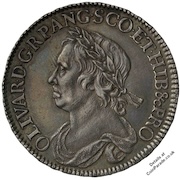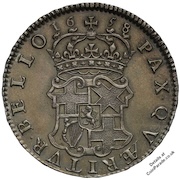
 The 1658 Half-Crown - Oliver Cromwell
The 1658 Half-Crown - Oliver CromwellWhen Cromwell first took over as Protector following his execution of King Charles I, the coins had no portraits and the legend was in English. But a decade later we see the bust of Oliver Cromwell on the obverse, wearing a laureate and draped, with Latin legend, and he now looks and acts like one of the the Monarchs he wanted to get rid of. This is one of the few British coins not to have a portrait of a monarch.
The coin itself is beautiful, rare and expensive. It was the early days of milled coinage and the dies made by Thomas Simon were being produced on the Pierre Blondeau presses.
Diameter 33mm, weigh 15g, metal: Silver. SCBC: 3227A.
There is some debate on if these coins should be classified as pattern coins. This is technically true as they had not been submitted to a Trial of the Pyx or mentioned in proclamations. But this was the period of the Roundheads and it was never said that the coins were NOT intended for circulation. Cromwell died later in 1658 so maybe we'll never know for sure.
The Obverse, by Thomas Simon, shows the laureated and draped bust of Oliver Cromwell facing left. Toothed border. Legend in Latin: "OLIVAR. D.G.R.P. ANG. SCO. ET. HIB &c PRO" meaning "Oliver, by the Grace of God, of the Republic of England, Scotland, Ireland etc., Protector".
Edge inscribed "+.HAS. NISI. PERITVRVS. MIHI. ADIMAT. NEMO" meaning "Let no one remove these from me under penalty of death".
 The Reverse, also by Thomas Simon, shows a crowned quartered shield with a lion in the centre. Toothed border. Legend around: "PAX QVÆRITVR BELLO" meaning "Peace is sought by war". Date divided across top.
The Reverse, also by Thomas Simon, shows a crowned quartered shield with a lion in the centre. Toothed border. Legend around: "PAX QVÆRITVR BELLO" meaning "Peace is sought by war". Date divided across top.Image credit: The Royal Mint . This coin graded by NGC as AU58.
Mintage: Rare
Minted at The Royal Mint
More information (monarch, year, mint, country, category) can be found below coin listings.
Below are some coins currently being offered on eBay. As an eBay Partner, We may be compensated if you make a purchase.
List items on:
List items on:
Remember 1658 ?
No Monarch. Oliver Cromwell is Lord Protector and the parliament is the Second Protectorate. Oliver Cromwell dies on 3rd September and Richard Cromwell becomes Lord Protector on the death of his father. First domestic pendulum clocks are sold in England, made by Ahasuerus Fromanteel of London.
Oliver Cromwell / Commonwealth (1649-1660)
Oliver Cromwell was not a Monarch but an English military and political leader and later Lord Protector of the Commonwealth of England, Scotland, and Ireland. As such his name did appear on coins. The actual monarch was Charles I, whom Cromwell was key in having executed.Cromwell was an MP but after one year King Charles didn't recall Parliament for nearly 11 years. Eventually the chasm between King and Parliament led to a Civil War. Oliver Cromwell was a talented military leader and won several battles with the Royalists, eventually defeating them and putting the King on trial leading to Charles I being put to death.
Cromwell as Protectorate (1653-1658) was a controversial figure. He deposed the Monarchy yet replaced it with his own ruthless, tyrannical rule. He signed himself 'Oliver P' (P for Protector) as in the style of Monarchs; he was referred to as 'his majesty' and paid himself £100,000 per year, which was a lot of money in the 1650s.
He was offered the Crown for the Monarchy in 1657 to help get stability back to the country, but eventually turned it down. After a short illness in 1658 he died, and his son Richard became Lord Protector but that didn't last long and Richard resigned in 1659. The monarchy was restored in 1660 when Charles II returned from exile. Oliver Cromwell's body (or what they thought was his body) was exhumed and posthumously executed.
Also in this category are 'Commonwealth' coins. These were issued between 1649 and 1660. They had no portraits, instead showing the Cross of St George and the Harp of Ireland. The inscriptions were in English rather than Latin so not as to be seen as associating with the Catholic Church. The Commonwealth coins often carried mint marks: 1649-57 was a Sun, and 1658-1660 was an Anchor. The anchor shows the protectorship was that of Richard Cromwell, Oliver's son.
Category: Half-Crowns
The half crown was a British coin which was valued at "2/6" (two shilling and sixpence) – 12½ pence in modern currency. It was literally half the value of the Crown.Half crowns were first issued around 1549 in gold or silver. It was then issued by the majority of Monarchs (plus Oliver Cromwell) all the way through to Elizabeth II. The last standard mintage was in 1967 and the coin was officially demonetised in 1970, one year before full decimalisation. A proof half crown was released in 1970.
The halfcrown was a large coin, from 1816 to it’s final minting having a diameter of 32mm and weight of 14.1g. In pre-decimalised Britain when the Crown was essentially a commemorative coin, the half crown was the largest denomination coin in circulation and had considerable spending power.
Before 1920, half crowns were actual sterling (92.5%) silver. This was reduced to 50% silver and in 1947 no silver at all was used and cupro-nickel became standard.
Half crowns are beautiful coins to collect and due to their long history they are very popular. As pre-1920 coins are 92.5% silver even worn copies will have the intrinsic price of the metal but they are still very affordable to most people.
Which Mint: The Royal Mint
The Royal Mint is the designated place for the UK to mint coins. It dates back well over 1000 years and is a Government-owned company. Formed in the reign of Alfred the Great about the year 886, during the period 1279-1812 it was generally referred to as The Tower Mint as it was housed at the Tower of London. The Master of The Royal Mint has included famous figures such as Sir Isaac Newton.
Since 2010 it has operated as Royal Mint Ltd, a company owned by HM Treasury, under an exclusive contract to supply all coinage for the UK although it also produces medals and coins for other countries. It is currently located at Llantrisant, Wales.
Country of Origin: United Kingdom
The United Kingdom (UK) is the Union of England, Scotland, Wales and Northern Ireland. It is often refered to as Great Britain (GBR). It has a long, rich history. The orignal coinage was Pounds, Shillings and Pence but since decimalisation on 15 February 1971, it is £1 = 100p, that is One Pound = 100 pence. The coinage of the UK is also a long history, the Royal Mint being established as long ago as 886AD when coins were hammered. Today there is perhaps 30 billion coins in circulation, and many (numismatic) collectors coins and sets are issued frequently in gold, silver and other metals.
Try the Half-Crowns page on eBay UK
As an eBay Partner, We may be compensated if you make a purchase.
As an eBay Partner, We may be compensated if you make a purchase.








